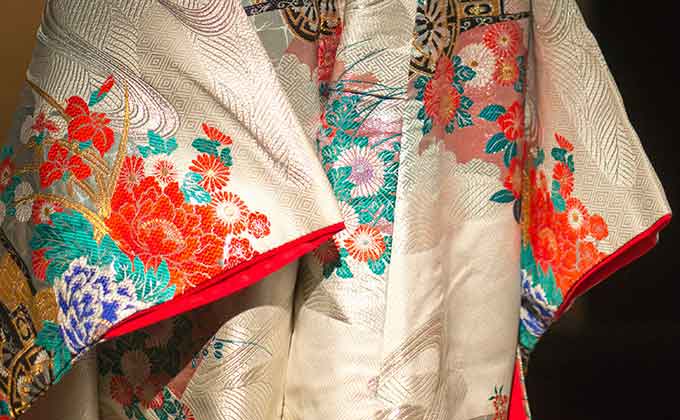
What is Japanese Embroidery?
Japanese embroidery is an embroidery technique that has been practiced in Japan since ancient times. The patterns on kimono and other garments are created using the advanced techniques cultivated in Japanese embroidery. Japanese embroidery makes kimonos look luxurious and gives "meaning to wear" by designing lucky charms. In this article, we will introduce such Japanese embroidery.
History of Japanese Embroidery

The history of Japanese embroidery is said to be long, beginning around the 5th century when it was introduced from the continent along with Buddhism. Later, as time went by, embroidery, which had previously been used mostly for embroidering Buddhist statues for religious purposes, came to be widely used for clothing decoration, and Japanese original techniques were created one after another. Most of the techniques used today were perfected by artisans from the Momoyama to Edo periods. During the Meiji and Taisho periods, embroidery using elaborate techniques became popular, and the finest examples of such craftsmanship can be seen in the kimonos, half collars, and obis that remain today. Today, embroidery is still used for kimonos, half collars, and other Japanese clothing, but its use has expanded to various accessories and interior decorations. Japanese embroidery fascinates viewers with its elegance and beauty, including its delicate use of color and three-dimensionality, the luster of the silk thread, and sophisticated designs based on classical patterns.
Tools Used in Japanese Embroidery

The following is a list of the main tools used in Japanese embroidery.
Yarn
Untwisted silk thread, called kamaito, is used either as is or twisted by the embroiderer. By combining several strands of thread, the thickness can be freely changed, and there are 500 to 600 colors available on the market. However, the number of companies producing Japanese embroidery thread has been decreasing. This is because the technology for making thread requires a very high level of skill, and it is very difficult to maintain and pass on the technology. The large number of different colors of threads makes it inevitably difficult to meet the needs of the market.
Pins
The pins are specially designed for Japanese embroidery. There are both handmade and machinemade needles, but handmade needles seem to be easier to use because they are more comfortable to use with the fabric. However, the price of these needles varies considerably. Machine made needles cost 700 to 1,000 yen for 10 needles, while handmade needles cost more than 1,000 yen each. There are also many types of needles. They are classified according to their thickness, such as kiritsuke and chubuto (medium thickness).
Embroidery table
These are assembled to stretch the fabric to be embroidered. Since Japanese embroidery is a two-handed embroidery, the fabric must be stretched firmly on the embroidery stand to work efficiently. Stretching the cloth on the embroidery stand is a tedious task in itself. It takes a certain amount of experience to achieve the right amount of tension. It is also difficult because the fabric shrinks when actually used, so it is necessary to calculate the shrinkage while making the embroidery.
Techniques of Japanese Embroidery

There are many techniques used in Japanese embroidery to express various patterns. They have created more realistic patterns and enriched the kimono. We will introduce four of the most representative ones.
What is Komadori?
It is a type of Japanese embroidery stitch, the same as the coaching stitch. It is called "Koma-embroidery. Gold, silver, or thick silk thread wound on a special thread roll called a "koma" is placed along the underpainting, and the thread is adjusted by manipulating the "koma" while being pressed inconspicuously with another thread. This technique is used for outlines and emphasized parts of a pattern, and is seen in works from the Kamakura period (1185-1333) onward. There are several ways of stitching such as "Honkoma", "Katakoma", "Yinkoma", "Hira ume", and "Chara nui". It is also called "Koma gaeshi nui," " Komadori," and "Fuse nui".
What is Sagara sewing?
First of all, let us introduce what Soraku stitch is. Soraku stitch, also called shuenir stitch, is an embroidery technique in which patterns are drawn by scooping up wool yarns. It is characterized by its fluffy feel and three dimensionality, and gives a warm feeling when you look at it. A loop is created by hooking the wool yarn onto a hook and pulling it up. The volume is totally different from other stitching methods because it uses a loop stitch, which is then finished into a pile shape.
What is a Sewing Cut?
When sewing pieces together, the seam allowance is sewn from one end of the fabric to the other. Depending on the pattern, one end may be sewn off and the other end may be sewn on.
What is a split stitch?
Split stitch is a method of starting a seam allowance after applying the pattern according to the mark. It is suitable for fabrics that tend to fray, such as thick fabrics and towels, because the seams are hidden and the fabric can be finished thin and clean. By using this technique, embroidery designs are not easily peeled off and can be used for a long time.
Summary of Japanese embroidery
As described above, Japanese embroidery has a long history that has been nurtured up to the present day, and the crystallization of techniques that are the result of the efforts of craftsmen of each era has been handed down to the present day. Although we may see embroidery without thinking about it, we may enjoy it in a different way if we can learn about the history and advanced techniques behind it.
